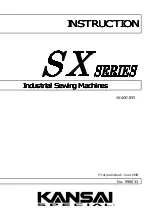
Operating instructions
KM 100/100 R B / KM 100/100 R LPG
English
25
!
Do not use any burning or
smouldering objects during filling
up or carry them with you or bring
them in the vicinity of the
appliance (explosion hazard).
!
Fill the tank at the most 1 cm
below the lower edge of the filler
neck, since the fuel expands in
heat.
!
Wipe off spilled over fuel and
close tank cap tightly.
Exercise caution when
handling liquefied
petroleum gas (LPG)
!
Use only LPG cylinders with a
power gas filling in compliance
with DIN 51622, quality A or B
respectively, depending on the
ambient temperature.
Note:
Household gas is forbidden!
Liquefied gas mixtures of
propane/butane whose mixing ratio
is between 90/10 and 30/70 are
permissible for the gas engine.
Since vaporisation already occurs at
low tempratures and because of the
improved cold-start performance, in
outdoor temperatures below 0°C
(32 °F) preference is to be given to
an LPG with a high propane
percentage.
Safety relevant guidelines
for LPG-powered vehicles
Principle association of the
commercial employers' liability
insurance association. Central office
for the prevention of accidents
- Valid as of 1.7.1950 -
Liquefied petroleum gases (fuel
gases) are BUTANE and
PROPANE, or a
BUTANE/PROPANE-mixture. They
are supplied in special cylinders.
The operating pressure for these
gases depends on the external
temperature.
Danger!
Do not handle liquefied petroleum
gas like petrol! Petrol vaporises
slowly, liquefied petroleum gas
vaporises immediately. The danger
of room gasification and ignition is
greater with liquefied petroleum gas
than with petrol.
Obligations of plant management
and the employer
!
All persons working with liquefied
petroleum gas are obligated to
appropriate knowledge about the
special characteristics of liquefied
petroleum gas necessary for the
safe operation of the enterprise.
The present document must
always accompany the sweeper.
Maintenance by specialists
!
Fuel gas systems are to be
checked by specialists for proper
function and seal (as per ZH
1/57) at regular intervals, at least
once a year.
!
The inspection must be certified
in writing. Basis for the
inspections are § 33 and § 37 of
regulations for the prevention of
accidents, "Utilisation of liquefied
petroleum gas"(VGB 21).
!
The guidelines for the inspection
of vehicles driven by liquefied
gas by the Federal Ministry for
Transportation from 29.09.1969
are applicable as a general rule.
Start up / operation
!
Gas may only be withdrawn from
one cylinder. Withdrawing gas
simultaneously from more than
one cylinder can cause LPG to
flood from one cylinder into
another. Following subsequent
closing of the cylinder's valve this
causes the overfilled cylinder
being subjected to an
impermissible rise in pressure
(cf. B. 1 of this guideline).
!
For mounting the full cylinder the
mark showing the correct position
of the cylinder is "top". (Threaded
connection points vertically
upwards)
The gas cylinders must be
exchanged very carefully. When
mounting and dismounting it the gas
outlet neck of the cylinder valve
must be sealed with a hexagon cap
nut firmly tightened with a spanner.
!
Leaking gas cylinders must not
be used again. They are to be
immediately emptied outdoors by
deflation while observing all
safety measures, and then
labelled as leaking. When
damaged gas cylinders are
delivered or fetched the renting
company or its representative
(service station attendant or
similar person) must immediately
be informed of this damage in
writing.
!
Prior to connecting gas cylinders
their connecting necks must be
inspected to ensure they are in
order.
!
After its connection the cylinder
must be tested for leaks using
foaming media.
!
The valves are to opened slowly!
Striking tools must not be used
for opening and closing.
!
Use only dry carbon dioxide
extinguishers or carbon dioxide
gas extinguishers on fires
involving LPG!
!
The whole LPG installation must
be regularly monitored for its
operational reliability, especially
regarding leaks. The use of
motor vehicles around leaking
gas systems is forbidden.
!
Close the cylinder valve prior to
disconnecting the union or the
hose connection. The connecting
nut on the cylinder must be
loosened slowly and at first only
a little, as otherwise the gas
under pressure in the line will
escape spontaneously.
!
If gas is replenished from a giant
gas holder the relevant
regulations shall be obtained
from the concerned LPG large-
scale distributor.
Danger!
Liquefied petroleum gas produces
frost-related injuries when it comes
into contact with bare skin!
Following removal the hexagon cap
nut must be tightly screwed onto the
cylinder’s connection thread.
To test whether the cylinder leaks,
soapy water, a nekal solution, or
other foaming agent is to be used.
Illuminating the liquefied gas system
with an open flame is forbidden..
The installation regulations of the
manufacturer must be observed
when replacing individual system
parts. Cylinders- and main stop
valves are to be closed.
The condition of the electrical
system of LPG-powered vehicles is
to be constantly monitored. Sparks
can cause explosions if there are
leaks in the gas-containing system
parts. Thoroughly ventilate the
adjusting bay prior to initial
operation of an LPG-powered
vehicle or its electrical systems
following any extended shutdowns
of such a vehicle.
The commercial employers' liability
insurance association and the
responsible trade supervisory office
must be notified immediately about
accidents concerning gas cylinders
or a liquefied gas system. Damaged
parts must be stored in a safe place
until the investigation is concluded.






































